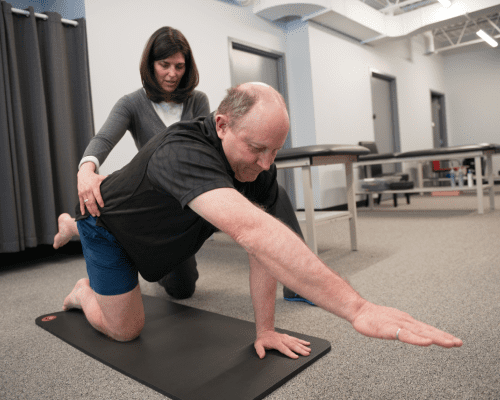Osteoarthritis is a clinical diagnosis. It should not be made just from viewing diagnostic images. Degenerative changes in our bones and joints happens with age. It happens at different rates in all of us. There are not direct correlations between symptoms and diagnostic images (X-ray, MRI, etc.).
Most clients with osteoarthritis are not receiving the best care from the healthcare system. Recent guidelines for osteoarthritis treatment include:
Engaging the patient/client regarding their goals and help them on a behavioral change journey that will include the following strategies:
- Exercise (including skilled exercise prescription and coaching; individual exercise is the best; providing exercise sheets without proper coaching and training is not effective)
- Self management strategies
- Weight loss (if appropriate)
A thorough physical examination will help identify what types of exercise and movement training will be most appropriate, and help target modifiable risk factors:
- Biomechanical assessment, including their trunk control and lower extremity/kinetic chain, in addition to their most painful joint (knee, hip, etc). Some examples of common findings may include:
- Poor Foot posture (stability motor control dysfunction – SMCD)
- Difficulty controlling femoral internal rotation (stability motor control dysfunction – SMCD)
- Decreased strength and function of their quadriceps muscles, gluteal muscles, etc
- Poor alignment/dysfunction somewhere along the kinetic chain (mobility, stability, or motor control)
These are the types of physical examinations that are performed everyday by skilled, engaged physiotherapists/physical therapists (such as those at Evolution Physiotherapy).
Once the treatment plan has been designed, the biggest challenge in making changes to improve osteoarthritis symptoms are behavioral changes. The adherence to these behavioral changes will be the toughest challenge! Good clinicians can help you with this by measuring monitoring, and motivating their clients.
If you are interested in reducing your pain and improving your function, we are here to help you.
The following blog post includes recommendations by David Hunter, an internationally recognized researcher and rheumatologist. For a full overview of his recommendations, listen to his February, 2017 British Journal of Sports Medicine podcast (BJSM) at http://feeds.bmj.com/bjsm/podcasts.

